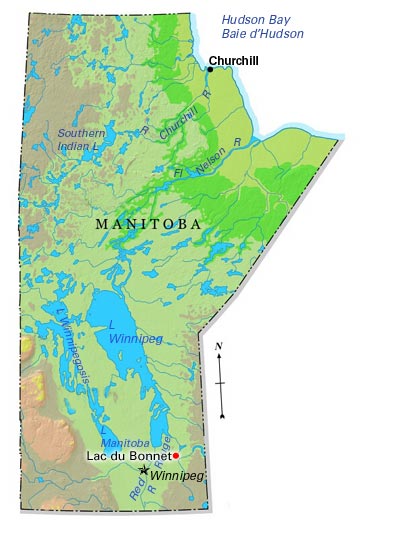Browse "Places"
-
Article
La Sarre
HistoryFounded in 1917, it was one of the first agricultural centres to be settled when the transcontinental railway opened up the Abitibi region around 1910.
"https://development.thecanadianencyclopedia.ca/images/tce_placeholder.jpg?v=e9dca980c9bdb3aa11e832e7ea94f5d9" // resources/views/front/categories/view.blade.php
https://development.thecanadianencyclopedia.ca/images/tce_placeholder.jpg?v=e9dca980c9bdb3aa11e832e7ea94f5d9
-
Article
La Tuque
La Tuque, Quebec, incorporated 1911, population 11,001 (2016 census), 11,227 (2011 census). La Tuque is located on the Rivière Saint-Maurice, 165 km north of Trois-Rivières. The town was built at the start of the 20th century at the site of a former trading post. It owes its name to a mountain shaped like a triangular woolen hat, popularly known as a “tuque.” The town’s economy is driven in large part by the forestry industry.
"https://development.thecanadianencyclopedia.ca/images/tce_placeholder.jpg?v=e9dca980c9bdb3aa11e832e7ea94f5d9" // resources/views/front/categories/view.blade.php
https://development.thecanadianencyclopedia.ca/images/tce_placeholder.jpg?v=e9dca980c9bdb3aa11e832e7ea94f5d9
-
Article
Labrador
The Torngat Mts of the far north rise in splendid isolation - the highest peaks east of the Rockies. Though in the same latitude as the British Isles, Labrador's forbidding terrain and extreme climate support only sparse settlement.
"https://d2ttikhf7xbzbs.cloudfront.net/media/media/697bba1d-7d03-4ef3-aa0b-5ac5d05a02bc.jpg" // resources/views/front/categories/view.blade.php
https://d2ttikhf7xbzbs.cloudfront.net/media/media/697bba1d-7d03-4ef3-aa0b-5ac5d05a02bc.jpg
-
Article
Labrador City
Labrador City, Newfoundland and Labrador, incorporated as a town in 1961, population 7,220 (2016 census), 7,367 (2011 census). The Town of Labrador City is in western Labrador near the Quebec border.
"https://development.thecanadianencyclopedia.ca/images/tce_placeholder.jpg?v=e9dca980c9bdb3aa11e832e7ea94f5d9" // resources/views/front/categories/view.blade.php
https://development.thecanadianencyclopedia.ca/images/tce_placeholder.jpg?v=e9dca980c9bdb3aa11e832e7ea94f5d9
-
Article
Labrador Current
The Labrador Current, famous for icebergs and once-abundant cod fish, is a southeasterly flow of water over the continental shelf and slope east of Newfoundland and Labrador, between Hudson Strait and the southern tip of the Grand Banks.
"https://development.thecanadianencyclopedia.ca/images/tce_placeholder.jpg?v=e9dca980c9bdb3aa11e832e7ea94f5d9" // resources/views/front/categories/view.blade.php
https://development.thecanadianencyclopedia.ca/images/tce_placeholder.jpg?v=e9dca980c9bdb3aa11e832e7ea94f5d9
-
Article
Labrador Highlands
Formed of ancient Precambrian rocks and heavily glaciated during the Quaternary (1.65 million to 10 000 years ago), the mountains support more than 70 small glaciers, the southernmost in eastern North America.
"https://development.thecanadianencyclopedia.ca/images/tce_placeholder.jpg?v=e9dca980c9bdb3aa11e832e7ea94f5d9" // resources/views/front/categories/view.blade.php
https://development.thecanadianencyclopedia.ca/images/tce_placeholder.jpg?v=e9dca980c9bdb3aa11e832e7ea94f5d9
-
Article
Labrador Sea
Labrador Sea is the body of water between Greenland and the coast of Labrador. It is 3400 m deep and 1000 km wide where it joins the North Atlantic and shallows to less than 700 m where DAVIS STRAIT separates it from BAFFIN BAY.
"https://development.thecanadianencyclopedia.ca/images/tce_placeholder.jpg?v=e9dca980c9bdb3aa11e832e7ea94f5d9" // resources/views/front/categories/view.blade.php
https://development.thecanadianencyclopedia.ca/images/tce_placeholder.jpg?v=e9dca980c9bdb3aa11e832e7ea94f5d9
-
Article
Lac à l' Eau Claire
Lac à l'Eau Claire, 1383 km2, elevation 241 m, max length 71 km, is located in northwestern Québec about 133 km east of the southeastern shore of Hudson Bay. Probably formed by the impact of a METEORITE, the lake drains west via Rivière à l'Eau Claire into Lac GUILLAUME-DELISLE.
"https://development.thecanadianencyclopedia.ca/images/tce_placeholder.jpg?v=e9dca980c9bdb3aa11e832e7ea94f5d9" // resources/views/front/categories/view.blade.php
https://development.thecanadianencyclopedia.ca/images/tce_placeholder.jpg?v=e9dca980c9bdb3aa11e832e7ea94f5d9
-
Article
Lac-Beauport
In the early 1800s the territory was opened up to exploit the forest resources. By the early 1820s the area around Lac Beauport was known as Waterloo Settlement. The first settlers were of English origin. In 1853 the parish municipality of Saint-Dunstan-du-Lac-Beauport was created.
"https://d2ttikhf7xbzbs.cloudfront.net/media/media/c17053a3-9a95-4ba1-8032-8c965bb82fee.jpg" // resources/views/front/categories/view.blade.php
https://d2ttikhf7xbzbs.cloudfront.net/media/media/c17053a3-9a95-4ba1-8032-8c965bb82fee.jpg
-
Article
Lac Bienville
Lac Bienville, 1249 km2, elevation 426 m, maximum length 89 km, is located in a sparsely populated region of northern Québec. This elongated lake, dotted with numerous islands, is fed by Lacs Louet and Ossant. It drains west, via the Grande Rivière de la Baleine (Great Whale River), into Hudson Bay.
"https://development.thecanadianencyclopedia.ca/images/tce_placeholder.jpg?v=e9dca980c9bdb3aa11e832e7ea94f5d9" // resources/views/front/categories/view.blade.php
https://development.thecanadianencyclopedia.ca/images/tce_placeholder.jpg?v=e9dca980c9bdb3aa11e832e7ea94f5d9
-
Article
Lac du Bonnet
Lac du Bonnet, Manitoba, incorporated as a rural municipality in 1917, population 2671 (2011c), 2812 (2006c). The Rural Municipality of Lac du Bonnet is located 100 km northeast of Winnipeg on Lac du Bonnet
"https://d2ttikhf7xbzbs.cloudfront.net/media/media/10511603-ff9a-4cd8-821c-641bba0ee988.jpg" // resources/views/front/categories/view.blade.php
https://d2ttikhf7xbzbs.cloudfront.net/media/media/10511603-ff9a-4cd8-821c-641bba0ee988.jpg
-
Article
Lac Guillaume-Delisle
Lac Guillaume-Delisle, 712 km2, is a large, triangular, saltwater lake in northern Québec, connected to the eastern shore of Hudson Bay by Le Goulet, a 5 km long narrow channel.
"https://development.thecanadianencyclopedia.ca/images/tce_placeholder.jpg?v=e9dca980c9bdb3aa11e832e7ea94f5d9" // resources/views/front/categories/view.blade.php
https://development.thecanadianencyclopedia.ca/images/tce_placeholder.jpg?v=e9dca980c9bdb3aa11e832e7ea94f5d9
-
Article
Lac La Biche
Lac La Biche, Alberta, incorporated as a municipal district in 2007, population 7,673 (2021 census), 8,330 (2016 census). Lac La Biche County is located 225 km northeast of Edmonton on the south shore of the lake of the same name. Incorporated as a town in 1951, Lac La Biche amalgamated with Lakeland County in 2007 to create Lac La Biche County.
"https://development.thecanadianencyclopedia.ca/images/tce_placeholder.jpg?v=e9dca980c9bdb3aa11e832e7ea94f5d9" // resources/views/front/categories/view.blade.php
https://development.thecanadianencyclopedia.ca/images/tce_placeholder.jpg?v=e9dca980c9bdb3aa11e832e7ea94f5d9
-
Article
Lac la Martre
Lac la Martre, 1777 km2, elev 265 m, max length 76 km, is located in the Northwest Territories, 50 km west of Behchokò and 150 km northwest of Yellowknife, and 346 km south of the Arctic Circle. The settlement of WHATÌ is located at the southeastern corner of the lake.
"https://development.thecanadianencyclopedia.ca/images/tce_placeholder.jpg?v=e9dca980c9bdb3aa11e832e7ea94f5d9" // resources/views/front/categories/view.blade.php
https://development.thecanadianencyclopedia.ca/images/tce_placeholder.jpg?v=e9dca980c9bdb3aa11e832e7ea94f5d9
-
Article
Lac La Ronge
Lac La Ronge, 1414 km2, elevation 364 m, is located in the rugged, sparsely populated Canadian Shield country of central Saskatchewan, 235 km north of Prince Albert. About 58 km long and studded with many islands, it drains northeast via the Rapid River into the Churchill River.
"https://development.thecanadianencyclopedia.ca/images/tce_placeholder.jpg?v=e9dca980c9bdb3aa11e832e7ea94f5d9" // resources/views/front/categories/view.blade.php
https://development.thecanadianencyclopedia.ca/images/tce_placeholder.jpg?v=e9dca980c9bdb3aa11e832e7ea94f5d9
